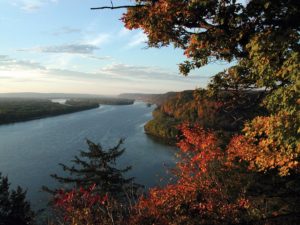Pool 11 on Upper Mississippi National Wildlife Refuge/USFWS
January 10, 2024
Protecting Midwest Wildlife Refuges
ELPC is stepping up to protect the Midwest’s ecological gems, our National Wildlife & Fish Refuges.
National Parks may be our most famous public lands, but there are amazing wild treasures under other federal agencies as well. The National Wildlife Refuge System, managed by the U.S. Fish and Wildlife Service, is an “unparalleled network of public lands and waters” that shelters many of the country’s most iconic and rare species. Out of the 560 refuges nationwide, you can find 53 right here in the Midwest, but they often face threats from encroaching proposals for highways, pipelines, transmission lines, and sprawl. ELPC is stepping up in two states to protect refuges, for the wildlife and communities who depend on them.
Refuge Threats
The 1997 National Wildlife Refuge System Improvement Act was passed in large part to stem the tide of secondary uses on refuge lands that were not compatible with the system’s wildlife purposes. Among the most serious problems, both then and now, have been “right-of-way projects” such as pipelines, transmission lines, and roads. Most of those are not “compatible” uses within the definition of the statute and USFWS rules, which provide that private economic uses like powerlines and pipelines must “contribute to” the wildlife purposes of refuges to meet the compatibility standard.
By their nature, right-of-way projects contribute to habitat fragmentation, reduce habitat quality, introduce contaminants, disrupt migration corridors, alter hydrology, facilitate the introduction of alien and invasive species, and disturb wildlife. Just last year, on March 21, 2023, the Council on Environmental Quality at the White House issued new guidance to all federal agencies “on Ecological Connectivity and Wildlife Corridors,” stating that it is now federal policy “to promote greater connectivity across terrestrial, marine, and freshwater habitats” and directing agencies to advance that objective in their decision-making.
The need is clear. Here are two places that ELPC is stepping up protect ecological gems in South Dakota and Wisconsin.
Sand Lake National Wildlife Refuge in South Dakota

Sand Lake National Wildlife Refuge, South Dakota
In the Great Plains of north-central South Dakota, the Sand Lake National Wildlife Refuge encompasses 21,498-acre of ecologically rich wetlands and a 11,450-acre lake. Thousands of waterfowl species and other birds depend on these natural resources as they migrate to and through the region every season. Local communities and tourists enjoy hunting, hiking, photography, and many other outdoor recreational activities here.
Recently, a proposed “compatibility determination” could have written a blank check for constructing “roads,” “water or fuel pipelines, power lines, telecommunications lines or towers, or other utilities.” ELPC and the National Wildlife Refuge Association submitted comments in November 2023, noting that such development is not consistent with the National Wildlife Refuge System Improvement Act, nor with stated federal policy.
Fortunately, the US Fish & Wildlife Service agreed with our comments that allowing large developments through the refuge violates the law and would be damaging for wildlife and biodiversity. FWS formally withdrew its compatibility determination and will now proceed in a more protective and legal way. That’s a win for South Dakota’s environment!
Upper Mississippi River National Wildlife & Fish Refuge in Wisconsin

Upper Mississippi River
Southwest Wisconsin’s Driftless Area is a unique stretch of the Midwest where the ancient glaciers did not carve flatlands, instead leaving rolling hills of karst geology. At the heart of the Drifltess area lies the Upper Mississippi River National Wildlife and Fish Refuge – a gem of the Midwest’s Refuge system, a key part of the Mississippi Flyway, and the fourth most visited national wildlife refuge in the nation. Unfortunately, the proposed Cardinal-Hickory Creek transmission line would cut a large swath through this ecologically rich area.
ELPC is in federal court opposing the proposed transmission line on behalf of our clients: the Driftless Area Land Conservancy, the Wisconsin Wildlife Federation, the National Wildlife Refuge Association, and Defenders of Wildlife. In January 2022, we achieved a major litigation victory when a federal judge held that the line cannot cross the refuge. One national expert says it’s the most important decision in the past 25 years for Wildlife Refuge protection! However, upon appeal, the court vacated its decision, saying ELPC and our clients raised these issues too early. We need to wait until the U.S. Fish and Wildlife Service issues a final decision to have our claims fully heard by the Court. ELPC will continue monitoring and advocating for more environmentally friendly and cost-effective alternatives to ensure the critically important wildlife refuge is protected.


